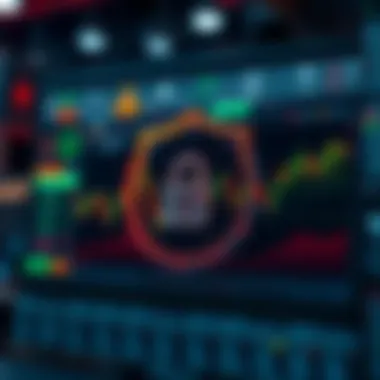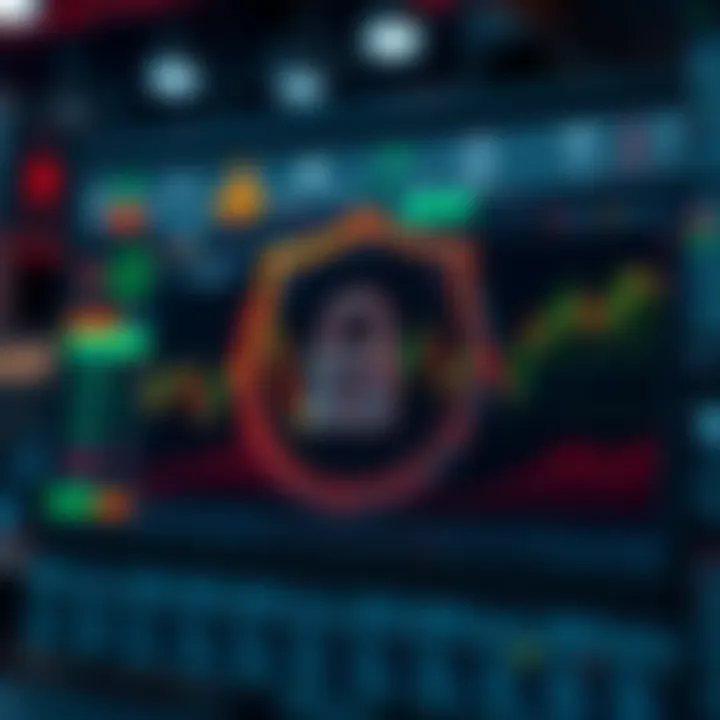Top Secure Trading Platforms for Safe Investments


Intro
In today's digital world, trading platforms serve as the bridge between investors and the dynamic market. With countless options popping up all the time, it becomes crucial to not only examine the available platforms but also scrutinize how secure they really are. The stakes are high—financial investments are often substantial, and the risks associated with trading scams and data breaches are very real. Whether you’ve been in the game for a while or are just stepping onto the field, understanding the security measures in place is key to safeguarding your capital.
This analysis will demystify the features that contribute to the safety of trading platforms. As we dive deeper, we will consider various aspects—from regulatory standards to user experiences—to help you identify which platforms prioritize security. Moreover, we shall compare the specifics of each platform, giving you the insight needed to navigate this intricate landscape successfully.
Investment Dictionaries
When diving into the world of trading, familiarity with distinct financial terms can bolster your competence. Let's break down some key concepts you may encounter as you evaluate trading platforms.
Key Financial Terms
- Liquidity: Refers to how easily an asset can be bought or sold in the market without affecting its price. High liquidity often signifies a more stable investmant.
- Volatility: Indicates the price fluctuations of an asset over time. Higher volatility could mean greater risks but also more potential for profit.
- Regulation: A set of rules imposed by governmental or independent agencies aimed at maintaining market integrity and protecting investors.
- Two-Factor Authentication (2FA): A security feature that requires not only a password but also a second factor, like a code sent to your mobile device, to gain access to your account.
Investment Jargon Explained
Deciphering the jargon within the trading sphere can almost feel like learning a new language. Here are a few terms to familiarize yourself with:
- Spread: The difference between the buying and selling price of an asset. In essence, it’s the broker’s fee built into the trades.
- Margin: The amount of capital required to open a leveraged position. Understanding margin helps you gauge risk exposure more effectively.
- Stop-Loss Order: An order placed to sell an asset once it reaches a certain price, used to minimize potential losses.
Understanding these terms isn't just beneficial; it's essential if you aim to navigate trading platforms without stumbling into pitfalls that could cost you dearly.
“Knowledge is power when it comes to investing; the more you know, the better equipped you are to protect your assets.”
Prelims to Trading Platforms
In today's digital age, the evolution of trading platforms has become a significant topic of discussion among investors and analysts alike. These platforms serve as the gateway to buying and selling assets, be it stocks, cryptocurrencies, or other financial instruments. Understanding the fundamental aspects of these platforms is critical, particularly in an environment where security breaches can endanger not just funds but also personal data.
This article aims to explore secure trading platforms comprehensively, shedding light on various features, security measures, and user experiences. Platforms aren’t just about their usability; they revolve around principal elements like security, technology support, and regulatory compliance. As a user, whether you’re a professional investor or an enthusiastic beginner, knowing what each platform brings to the table can enhance your trading experience.
Furthermore, a stable platform can offer significant benefits. Efficient execution of trades, user-friendly interfaces, and competitive fee structures are just a few advantages. However, the real crux lies in the notion of security—how well a platform protects you against fraud, cyber attacks, and regulatory pitfalls. There can be more than a few fishy practices out there, and having solid knowledge on how to navigate this can mean the difference between success and failure in your trading journey.
Consider this: the very nature of trading is akin to stepping into a high-stakes poker game where your capital is at risk. Just as you would not play your hand blindly, you shouldn't trust a trading platform without first understanding its security protocols and track record. This is what makes diving deeper into each platform essential.
Understanding Trading Platforms
Trading platforms are software applications that allow traders to execute buy and sell orders for various financial instruments. They come in different shapes and sizes, catering to a variety of user needs—from basic brokerage services to advanced features tailored for seasoned traders.
Typically, you can find functionalities like charting tools, market analysis, risk management tools, and algorithmic trading options in these platforms. However, the user experience varies widely, emphasizing the importance of conducting thorough research before placing any trades.
It's also worth noting that there exists a myriad of types of trading platforms:
- Web-Based Platforms: Accessible from any device with internet connectivity.
- Desktop Applications: Require installation and often offer more robust features.
- Mobile Trading Apps: Allow for trading on-the-go, though often limited in functionality compared to their desktop counterparts.
The inclusion of support features such as live chat and responsive customer service can enhance one’s experience, making order placements smoother and potentially minimizing costly mistakes.
The Importance of Security in Trading
With the rise of online trading comes the raising stakes in securing your investments. The very backbone of any successful trading platform hinges on its ability to safeguard user data and transactions. Without robust security, even the most feature-rich platform pales in comparison.
In recent years, there have been notable security breaches that have rattled the confidence of users worldwide. Instances where hackers infiltrated exchanges, stealing not just currency but also personal credentials, underline the necessity for a secure approach.
"The question isn’t if you will be targeted, but when."
This comes as a stark reminder to evaluate security measures like encryption protocols, which are paramount in protecting sensitive financial data. Two-factor authentication has also emerged as a common safeguard among platforms, offering an additional layer of protection against unauthorized access.
Moreover, compliance with regulatory standards plays a crucial role. Platforms adhering to guidelines established by regulatory authorities (like the Securities and Exchange Commission in the USA) are generally considered more reliable. Investing time to understand these aspects not only mitigates risk but also paves the way for a more informed trading experience.
In summary, knowing the nuts and bolts of trading platforms equips you to make sound investment choices. With a myriad of options at your fingertips, prioritizing those that exhibit high security standards should never be an afterthought, rather a foundational criterion in your selection process.


Criteria for Security in Trading Platforms
When stepping into the realm of online trading, security is not just a luxury—it's a necessity. As more individuals engage in digital trading, the sharp uptick in cyber threats prompts investors to critically assess the platforms at their disposal. Understanding what makes a trading platform secure goes beyond surface-level features. It delves into the very bedrock upon which trust is built, which includes encryption protocols, two-factor authentication, and regulatory compliance.
Encryption Protocols
Encryption protocols serve as the first line of defense in protecting sensitive data. Imagine you have a box of prized possessions; you wouldn't just leave it out in the open. You'd lock it and guard it. Similarly, encryption scrambles your data so that it’s unreadable to anyone without the right key. This is vital for any transaction that involves personal information or financial data. A platform using advanced encryption protocols, like AES (Advanced Encryption Standard), ensures that even if a cybercriminal tries to intercept data, they’d likely come up empty-handed.
Moreover, not all encryption protocols are created equal. Each has its own strengths and weaknesses, which is why it’s important to scrutinize the specifics of what a platform offers. Platforms should ideally provide robust encryption during both data storage and transmission. This not only safeguards data when it’s in transit across the internet but also while it’s resting on servers. In the end, a well-encrypted platform acts as a digital vault, significantly lowering the chance of theft.
Two-Factor Authentication
Moving deeper into security protocols, two-factor authentication (2FA) stands out as an indispensable measure. Picture this: you have a door lock, but what if someone could simply walk through it while you were out? That's what relying solely on a password does. 2FA requires users to present two distinct forms of identification before gaining access to their accounts—typically something they know (like a password) and something they have (like a smartphone).
The practicality of implementing 2FA cannot be overstated. It’s akin to having a security alarm system alongside your deadbolt. Even if a hacker manages to get your password, they would still face a substantial hurdle if they lack access to your second authentication factor. The additional layer of security offered by this method significantly deters unauthorized access, enhancing the overall safety of the trading environment.
Regulatory Compliance
Finally, the importance of regulatory compliance in trading platforms offers another layer of assurance that should not be overlooked. Regulatory bodies, such as the Securities and Exchange Commission (SEC) in the United States or the Financial Conduct Authority (FCA) in the United Kingdom, set guidelines that trading platforms must abide by to protect investors and maintain market integrity. These regulations often mandate strict security protocols, reporting standards, and system audits.
When a platform is compliant with recognized regulatory frameworks, it exhibits a commitment to transparency and security. This compliance assures users that their investments are in safe hands. Furthermore, platforms that adhere to such standards often face penalties and sanctions for any violations, thus acting as a safety net for investors. To sum it up, regulatory compliance is not just an afterthought; it is a strong indicator of a platform's reliability and security.
"In the world of trading, security isn't a feature—it's a necessity."
Each of these criteria—encryption protocols, two-factor authentication, and regulatory compliance—serves a critical role in safeguarding user information and investments. Awareness of these components can empower investors to make more informed choices in a crowded marketplace of trading platforms.
Top Trading Platforms Examined
In the quest for securing financial assets through trading, identifying robust platforms cannot be understated. The Top Trading Platforms Examined section offers an essential insight into specific platforms that prioritize user security while still delivering a seamless trading experience. By analyzing different platforms, readers can gauge what makes a trading platform not just functional but secure and reliable.
Platform A: Overview and Security Features
Platform A has emerged as a formidable contender in the trading arena, particularly due to its advanced security mechanisms. From two-factor authentication to encryption protocols, this platform takes significant measures to safeguard user data. Its commitment to compliance with regulatory standards also enhances users' confidence. Furthermore, the user interface is designed to be intuitive, which lowers the barrier for new traders while still catering to seasoned users.
Customer Feedback
Customer feedback for Platform A tends to highlight its user-friendly design and impressive security features. Many users appreciate how streamlined the process is when setting up accounts and implementing security measures. An interesting facet of the feedback is that users call out the 24/7 customer support line as a vital element, enhancing the overall trading experience.
However, some criticism arises regarding the occasional lagging during peak trading hours, which can be a concern when every second counts. This trade-off seems to resonate with many as the platform continues to be a popular choice amongst both novice and professional traders.
Strengths and Weaknesses
The strengths of Platform A lie mainly in its combination of strong security layers and an appealing interface. The core of its security strategy is encryption, which helps to protect sensitive information from cyber threats. Moreover, the platform implements rigorous identity verification methods that make unauthorized access nearly impossible.
Conversely, its weaknesses include vulnerabilities apparent during high traffic times—leading to potential trading opportunities missed. Additionally, the platform charges higher transaction fees, which may deter some cost-conscious traders. As users weigh the pros and cons, it’s evident that Platform A strikes a decent balance between security and usability even if it falters slightly under pressure.
Platform B: Overview and Security Features
Platform B presents an impressive package with its comprehensive security protocols blended into a user-friendly design. They have made a considerable effort to focus on transparency, which means users know exactly what safeguards are in place. Security audits conducted regularly and a good track record with regulatory bodies bolster its reputation further.
Customer Feedback
Feedback regarding Platform B leans toward positive, with many users commenting on the transparency and reliability of its services. One notable aspect users appreciate is the platform's clear communication regarding security protocols and updates. There's a strong sense of community engagement, with many users feeling part of a proactive trading space. However, some users have pointed out a lack of diverse trading options compared to competitors, which they feel can limit flexibility.
Strengths and Weaknesses
The major strength of Platform B is its active user community, which aids in consistently improving platform security measures. Regular feedback loops established by the developers allow users to contribute thoughts and suggestions, giving a strong sense of investment in the platform's evolution.
On the downside, its weakness comes from a rather limited arsenal of asset choices. For traders looking for diverse investment options, the platform may not measure up against competitors. This can push some users toward platforms like A or C that offer broader opportunities but may lack in certain security features.


Platform C: Overview and Security Features
Platform C has carved its niche through innovative technology and a robust commitment to user security. This platform introduces various unique security features like blockchain technology for transaction verification. Their approach is at the forefront of security trends, demonstrating a proactive stance rather than a reactive one.
Customer Feedback
Users are often wowed by Platform C's cutting-edge technology and its implications for their trades. Feedback indicates that many feel confident in the platform’s security, particularly because it takes advantage of blockchain’s inherent transparency. However, some users have voiced concerns about the learning curve associated with these advanced features, which can lead to frustration initially.
Strengths and Weaknesses
The strengths of Platform C are rooted in its forward-thinking approach. Utilizing blockchain ensures not only unmatched security but also speeds in transaction processes. The platform is viewed as extremely safe, and its features are increasingly appealing to tech-savvy investors. Yet, the weakness is that its advanced tools can be daunting for new traders. A learning curve exists that may discourage less experienced users—an essential consideration for platforms looking to appeal to a broad audience.
Comparative Analysis of Platforms
When we stack Platform A, B, and C against each other, some clear distinctions emerge:
- Platform A shines in customer support and user-friendliness but faces drawbacks during high volumes.
- Platform B benefits from its community feel and transparency but struggles with a lack of trading options.
- Platform C leads in advanced security and transaction speed but may not cater ably to beginner investors.
User Experiences and Case Studies
When it comes to selecting a trading platform, the weight of user experiences and case studies cannot be overstated. They serve as practical illustrations of security in action. Reading about other investors’ triumphs and challenges can offer invaluable insights, aiding users in making more informed decisions about where to stake their money.
Real-world examples provide a grounding that technical specifications alone can’t offer. People are often swayed by personal anecdotes. Hearing how a platform stood firm in the face of attempted breaches or engaged swiftly with users when issues materialized, confirms a commitment to security that mere marketing claims cannot convey. Moreover, these narratives delve into the minutiae of using a platform—something that could help users sidestep potential pitfalls that might not be evident on the surface.
“The voice of the customer is the best way to personalize security features in trading platforms,” remarked a security expert.
By evaluating case studies, traders can gain perspectives on usability alongside security features. For instance, an investor might find that while one trading platform boasted robust security measures, its user interface was cumbersome. On the flip side, another platform might prioritize ease of use at the expense of certain security protocols.
User Testimonials on Security
In the digital age, peer reviews and testimonials can significantly influence a trader's choice of platform. Users often document their experiences extensively. This feedback can reveal critical information about how a platform responds when faced with security threats. For instance, a trader might recount an incident where they received timely alerts about suspicious activity on their account. Such feedback not only informs potential users about security measures but also underscores the platform’s active engagement with its clientele.
- Positive Testimonials: A frequent theme in favorable reviews includes rapid two-factor authentication, frequent updates on evolving security practices, and effective customer support that reassures users.
- Negative Testimonials: Conversely, some traders share experiences of poor response times or a lack of transparency, which can catalyze fear among potential investors about the specific platform's reliability.
Ultimately, positive user experiences lend credence to a platform's security reputation, while negative feedback can serve as a cautionary tale for prospective users.
Lessons Learned from Security Breaches
Security breaches are all too real in the world of trading platforms, and they offer rich material for learning. Analyzing past breaches paints a clearer picture of what to look for in a secure trading environment. For instance, a well-publicized breach in 2020 at Trading Firm X shed light on critical vulnerabilities. It was discovered that poor encryption practices allowed hackers to siphon off sensitive data of thousands of users. This incident emphasized the need for robust encryption protocols, which are now more widely adopted in the industry as a standard.
Key takeaways from such breaches include:
- Proactive Measures: Following a breach, many platforms enhanced their security, adopting proven encryption technologies and stricter authentication procedures.
- Regulatory Changes: Regulatory bodies often take note of major incidents, advocating for improved compliance measures that can prioritize investor safety.
- Enhanced Awareness: Users are now more vigilant about platform security and often demand higher levels of transparency regarding security protocols.
In summary, both positive and negative user experiences provide a rich tapestry of knowledge from which future traders can learn. This information helps inform decisions around security measures and the overall reliability of trading platforms.
Deciding Factors for Choosing a Secure Trading Platform
When it comes to choosing a secure trading platform, there’s more than meets the eye. The digital world is like a bustling market where you have to mind your purse, lest someone make off with your precious investments. In this sense, the decision becomes not just about picking a platform, but ensuring you’re stepping into a secure investment environment. The factors that weigh into this decision are multifaceted and can make a world of difference in your trading experience.
Assessing Personal Investment Goals
Before jumping in headfirst, it’s crucial to take a step back and evaluate your personal investment goals. Are you a cautious investor only looking to dip a toe in the water, or are you more of a thrill-seeker hoping for rapid growth? Knowing where you stand plays a pivotal role in selecting a trading platform suited to your style.
Investors need to consider things like time horizon and risk appetite. Long-term investors might favor platforms that provide educational resources and robust research tools, while those looking for quick returns might seek platforms with low latency and advanced trading features. It’s like picking a route for a road trip—know your destination before you choose the map.
Evaluating Customer Support


Another deciding factor that can’t be overlooked is the quality of customer support. After all, not everything goes according to plan in the trading universe. You might encounter technical snags or require clarifications that could leave you feeling like a fish out of water. Therefore, consider the availability and responsiveness of the customer support team.
Look for features like:
- 24/7 availability: This offers peace of mind, especially for international traders.
- Multichannel support: Options like live chat, phone support, and email ensure you can reach out in the way that suits you best.
- Resources for self-help: A well-documented FAQ section or knowledgebase can save you a ton of time when issues arise.
It’s essential to test the waters by reaching out before fully committing to a platform—if their response time is quicker than a cat on a hot tin roof, you might have found your match.
Considering Fees and Commissions
The old adage "you get what you pay for" holds true, but it's important to sift through the fees and commissions like a jeweler examining stones. Every platform has its own pricing structure, and it’s key to understand how these costs will impact your overall trading strategy. A low commission might seem appealing, but factors like withdrawal fees, inactivity fees, or hidden costs can add up over time—taking a good chunk out of your returns.
Consider the following:
- Trading fees: Usually the most visible fees and commonly charged per trade.
- Account maintenance fees: These are often overlooked but can be an ongoing cost.
- Spread costs: Understand the difference between the bidding and asking price, as this can affect your trade profitability.
To summarize, the quest for a secure trading platform involves pinpointing personal investment goals, scrutinizing customer support quality, and understanding the fee structure—all of which contribute to a smoother trading journey and a fortified sense of security.
Future of Security in Trading
In the fast-paced world of online trading, the future of security is not merely an afterthought; it's a vital component that shapes the very foundation of how investors operate. The significance of focusing on security measures today cannot be overstated; as technology advances, so do the tactics employed by cybercriminals. Therefore, investors, financial advisors, and analysts must keenly consider the evolving landscape of security in trading platforms.
The trajectory of security in trading is guided by emerging technologies and regulatory shifts, both of which deserve a closer look.
Emerging Technologies
Emerging technologies reshape the trading environment, leading to better security measures. Here are some notable advancements:
- Blockchain Technology: This decentralized ledger technology not only adds transparency but also significantly enhances security. Transactions recorded on the blockchain are virtually tamper-proof, making it an ideal foundation for secure trading platforms.
- Artificial Intelligence and Machine Learning: These technologies are revolutionizing risk assessment and fraud detection. Investing platforms equipped with AI can analyze trading patterns, user behavior, and market trends to identify anomalies and potential threats. They adapt in real-time, bolstering defenses against increasingly sophisticated attacks.
- Enhanced Encryption Methods: While traditional encryption has been effective, the new algorithms promise better protection against hacking attempts. Quantum encryption, for example, is gaining traction due to its capability to thwart all types of eavesdropping.
Security is not just a feature; it is the backbone of trust in trading. As the industry adapts, these technologies will be at the forefront of reshaping investor confidence.
The advantages of adopting these emerging technologies include not only increased security but also improved user experience. When platforms implement blockchain or AI effectively, they can streamline processes that may have previously caused delays or issues.
Regulatory Changes Ahead
Another crucial aspect is the pending regulatory changes that will reshape the security landscape in trading. Government agencies and regulatory bodies have begun taking a more active role in overseeing trading practices, responding to security breaches, and enforcing stricter compliance standards. Here’s what these potential changes could encompass:
- Stricter Data Protection Laws: Following global trends, you can expect more stringent regulations regarding user data privacy. Platforms will need to emphasize data handling practices, ensuring that investor information is not just protected but also managed transparently.
- Increased Cybersecurity Standards: Regulatory bodies are likely to impose higher cybersecurity standards on trading platforms. This means that platforms may be required to undergo regular security audits, further strengthening their defenses against breaches.
- Enhanced Reporting Requirements: To combat fraud and cybercrimes, platforms may need to implement more comprehensive reporting structures. Timely disclosures about breaches or suspicious activities could become mandated practices.
- Investor Education Initiatives: Regulators might promote education initiatives to inform investors about security risks and best practices when trading online. This could empower users to recognize red flags and protect themselves effectively.
Navigating this landscape will require stakeholders to remain aware of every regulatory change as they emerge. The emphasis on security not only protects investor interests but also promotes a stable trading environment, which, in turn, yields better trust in the market.
In sum, the future of security in trading platforms is not just a trend; it's a fundamental shift that necessitates attention from every participant in the trading arena. By embracing these emerging technologies and staying abreast of regulatory changes, investors can better safeguard their assets in an increasingly complex digital landscape.
Ending
The world of online trading is not just about buying and selling assets; it's about securely navigating a complex landscape filled with opportunities and risks. The importance of choosing a secure trading platform cannot be overemphasized. As we’ve explored, security measures protect against unauthorized access, data breaches, and financial losses, making them fundamental in preserving investor trust. In a market that continues to evolve rapidly, understanding the various security aspects is crucial for anyone serious about investing.
Summarizing Key Insights
In our examination of the most secure trading platforms, several key insights have emerged:
- Security First: Effective platforms prioritize security above all. This includes robust encryption protocols and two-factor authentication, providing a solid defense against potential breaches.
- Regulatory Compliance: Platforms that comply with financial regulations offer an added layer of safety, ensuring that they adhere to standards protecting investors' interests.
- User Feedback Matters: Listening to real user experiences reveals not only the strengths and weaknesses of each platform but also highlights how these platforms handle security incidents when they arise.
Furthermore, emerging technologies are reshaping the landscape. Strategies like biometric verification and blockchain integration are becoming more commonplace, further enhancing security measures.
Final Thoughts on Choosing a Secure Platform
When it comes to selecting a secure trading platform, a few considerations can guide investors:
- Understand Your Needs: Not all platforms suit all investors. Analyze your trading habits and requirements to find the right fit.
- Examine Security Features: Look under the hood; ensure the platform employs encrypted communication and comprehensive monitoring systems.
- Seek Transparency: Reliable platforms should openly share their security practices and incident histories.
Ultimately, while the search for security can feel overwhelming, focusing on platforms that take security seriously can pave the way for a safer trading experience. As the market continues to change, a discerning eye will help investors make informed decisions that balance security with investment opportunities. For more information on trading platform security, check resources such as Wikipedia or Britannica.
Remember, investing is not only about the gains but also about safeguarding what you've built.



